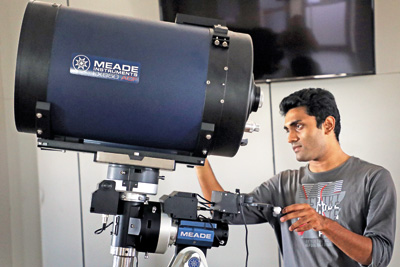News
Lanka’s young stellar great’s tryst with two new exoplanets
Mahesh Herath knows that science fiction and space art can be wild pipe dreams. The decade, whose end we are now approaching, was predicted to foster human colonies on planet Neptune — “whereas we haven’t even been to Mars yet!”

At 28, Mahesh along with his mentors was among the first Sri Lankans to identify a new exoplanetary system consisting of two planets.
Nevertheless such visions are what shape great astronomers and scientists: the enigma of the night sky and the distant polar star — the lure of interstellar travel and meeting alien intelligence.
At 28, Mahesh himself could be held one of the ‘stellar greats’. He was the first Sri Lankans together with his mentors to identify a new exoplanetary system consisting of two planets.
For Mahesh, research runs in the family. His father, Dr. Chula Herath, consultant nephrologist, broke fresh ground discovering there could be a chemical at the heart of the chronic kidney disease, and it was not merely due to heat as was earlier supposed.
Mahesh is a product of Royal College and Colombo International School. After his first degree at Southampton, he went to the Katholieke Universiteit Leuven in Belgium. In its hallowed ancient halls, he garnered a Master’s in Space Science. He may well be one of the youngest to occupy an office within the rambling complex of the Arthur C Clarke Institute for Modern Technologies (ACCIMT). He is mentored by two of the visionary Clarke’s protégés — Prof. Chandana Jayaratne, Senior Lecturer in Physics at Colombo University and Astronomy and Space Applications Consultant at the institute; and Dr. Saraj Gunesekera, Acting Director (Space Technologies and Applications) ACCIMT.
Exoplanets are planets outside our solar system. There are today some 4,100 exoplanets identified. Anyone dreaming of casting about for new exoplanets can use data made available by the United State’s National Aeronautics and Space Administration (NASA).
Mahesh developed an algorithm that can comb through thousands of observed data sets. With Dr. Saraj and his team, they isolated one star — named EPIC 212737443, which was observed during Campaign 6 of the Kepler/K2 mission. After many months of observation the team was able to discover two planets orbiting this star.
The first step towards recording the find was getting published in the Monthly Notices of the Royal Astronomical Society (MNRAS), the most prestigious of astronomical journals.
The discovery was also accepted by NASA/JPL, the California Institute of Technology and University of St Andrews among others. The new planets have now been added to the NASA exoplanet archive, the Exoplanet Encyclopaedia and Wikipedia.
After being published, it was just a short step to getting the names of the planets registered, though the team found they cannot commemorate any of their beloved or give free rein to flights of fancy. The planets have to be named after the telescope that sighted them, so instead of a poetic christening, the two exoplanets got the decreed names K2-310b, and K2-310c.
A team from 11 foreign universities were involved in ‘sizing up’ the two planets to explore and establish the character of this new solar system. K2-310b, with a radius of 16,500 km, has 2.6 times the radius of the Earth, and an equilibrium temperature of 263 degrees centigrade, while the larger second planet has a radius of 17,220 km (2.7 times the radius of the Earth) and an equilibrium temperature of 42 degrees centigrade.
Of course, a lot remains to be known — even whether these are rocky planets (like our Earth) or gaseous planets (like Jupiter or Saturn).
Mahesh also drops tantalising clues to other discoveries about to be revealed. “Hopefully, in a matter of months, the Institute can reveal more exciting news.”
The core message the young scientist wants out is that science needs more people on the bandwagon including those without formal training.
“There’s more data out there than scientists know what to do with.”
“So at the end of the day,” he says, “it’s important not to monopolise science”. He looks forward earnestly to what is to him a more desirable state where anyone who wants can do scientific research and publish their findings “because if you think about it, the more people that contribute towards finding something, the more chances there are of making many more ground breaking discoveries.”

